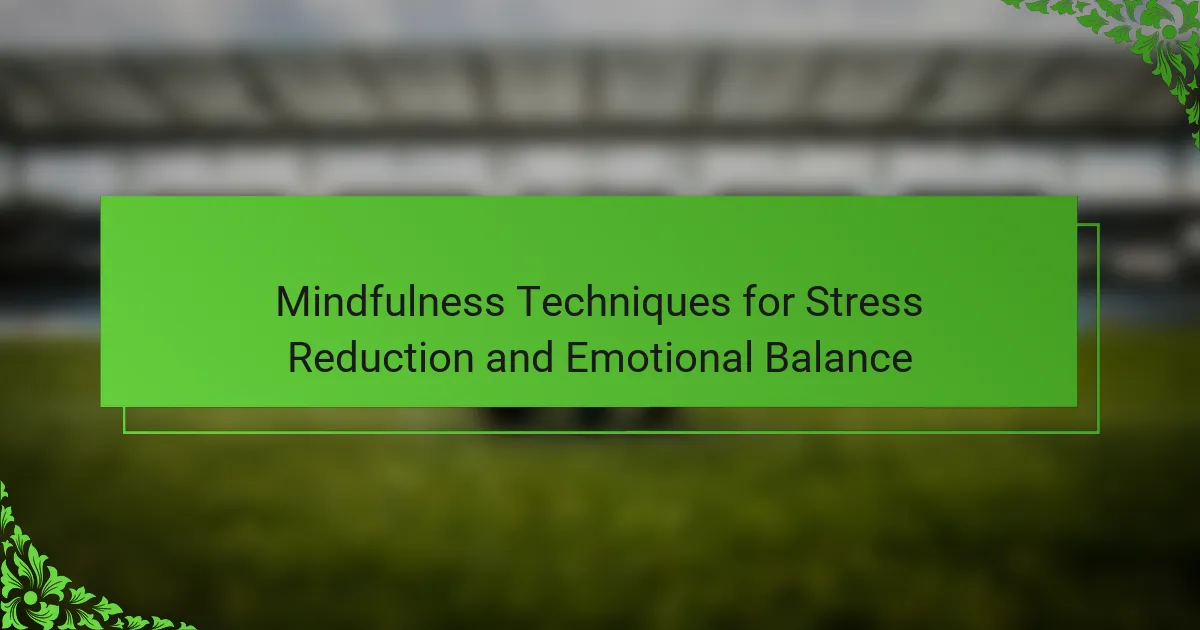Anxiety disorders significantly impact daily life, causing excessive worry and fear. This article explores the various types, including generalized anxiety disorder and panic disorder, outlines common symptoms, and reviews effective treatment options such as therapy and medication. Understanding the underlying factors contributing to these disorders is crucial for effective management and recovery.
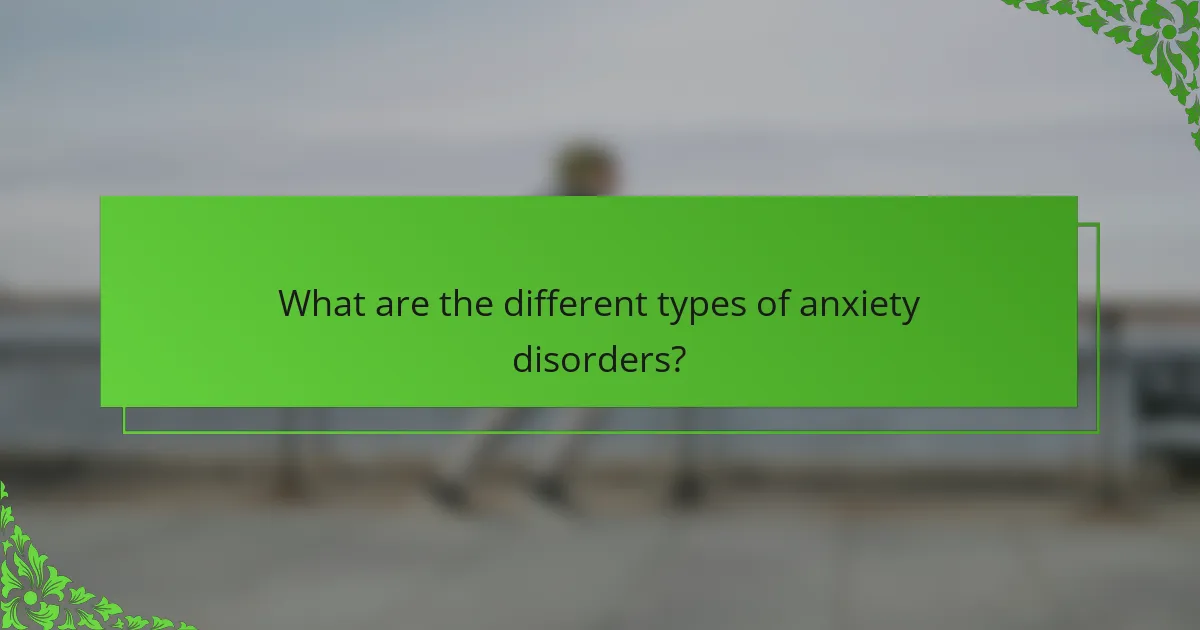
What are the different types of anxiety disorders?
Anxiety disorders encompass several types, including generalized anxiety disorder, panic disorder, social anxiety disorder, and specific phobias. Each type presents unique symptoms and treatment options.
Generalized anxiety disorder involves excessive worry about various aspects of life. Panic disorder is characterized by recurrent panic attacks. Social anxiety disorder leads to intense fear in social situations. Specific phobias trigger irrational fear of specific objects or situations.
Treatment options vary but often include therapy, medication, and lifestyle changes. Cognitive behavioral therapy is effective for many types. Medications like SSRIs can help manage symptoms. Mindfulness and relaxation techniques may also provide relief.
How do generalized anxiety disorder and panic disorder differ?
Generalized anxiety disorder (GAD) involves excessive worry about various aspects of life, while panic disorder is characterized by sudden panic attacks. GAD symptoms include chronic anxiety and tension, whereas panic disorder features intense fear and physical symptoms like heart palpitations. Treatment options vary; GAD often benefits from cognitive-behavioral therapy and medication, while panic disorder may require exposure therapy and specific medications. Understanding these differences aids in effective management strategies for each condition.
What are the characteristics of social anxiety disorder?
Social anxiety disorder is characterized by intense fear of social situations. Individuals often fear judgment or embarrassment, leading to avoidance behaviors. Symptoms include excessive sweating, rapid heartbeat, and difficulty speaking. Treatment options encompass therapy, medication, and self-help strategies, improving social functioning and quality of life.
Which symptoms are associated with specific phobias?
Specific phobias can cause various symptoms, including intense fear, rapid heartbeat, sweating, and dizziness. These symptoms often occur when confronted with the phobic stimulus or even when anticipating it.
Common symptoms associated with specific phobias include:
– Intense anxiety or panic attacks
– Rapid heartbeat
– Shortness of breath
– Nausea or gastrointestinal distress
– Trembling or shaking
– Avoidance behavior towards the phobic object or situation
The severity of symptoms can vary based on the individual and the specific phobia. Understanding these symptoms is crucial for effective treatment options.
What is the impact of obsessive-compulsive disorder on daily life?
Obsessive-compulsive disorder significantly disrupts daily life by causing intrusive thoughts and compulsive behaviors. Individuals may spend hours performing rituals, leading to reduced productivity and strained relationships. Daily tasks become overwhelming, and anxiety levels increase due to the constant need to manage obsessions and compulsions. This condition often results in avoidance of certain situations, further isolating individuals and impacting their overall quality of life.
How does post-traumatic stress disorder manifest in individuals?
Post-traumatic stress disorder (PTSD) manifests in individuals through symptoms such as intrusive memories, avoidance behaviors, negative changes in mood, and heightened arousal. These symptoms can disrupt daily functioning and relationships.
Intrusive memories often include flashbacks or distressing thoughts related to the traumatic event. Individuals may avoid reminders of the trauma, leading to social withdrawal. Negative mood changes can involve feelings of hopelessness, detachment, or anger. Heightened arousal may present as increased anxiety, irritability, or sleep disturbances.
PTSD symptoms can vary in intensity and duration, with some individuals experiencing them soon after the trauma, while others may develop symptoms much later. Early intervention and treatment options, such as cognitive-behavioral therapy and medication, can significantly improve outcomes for those affected.
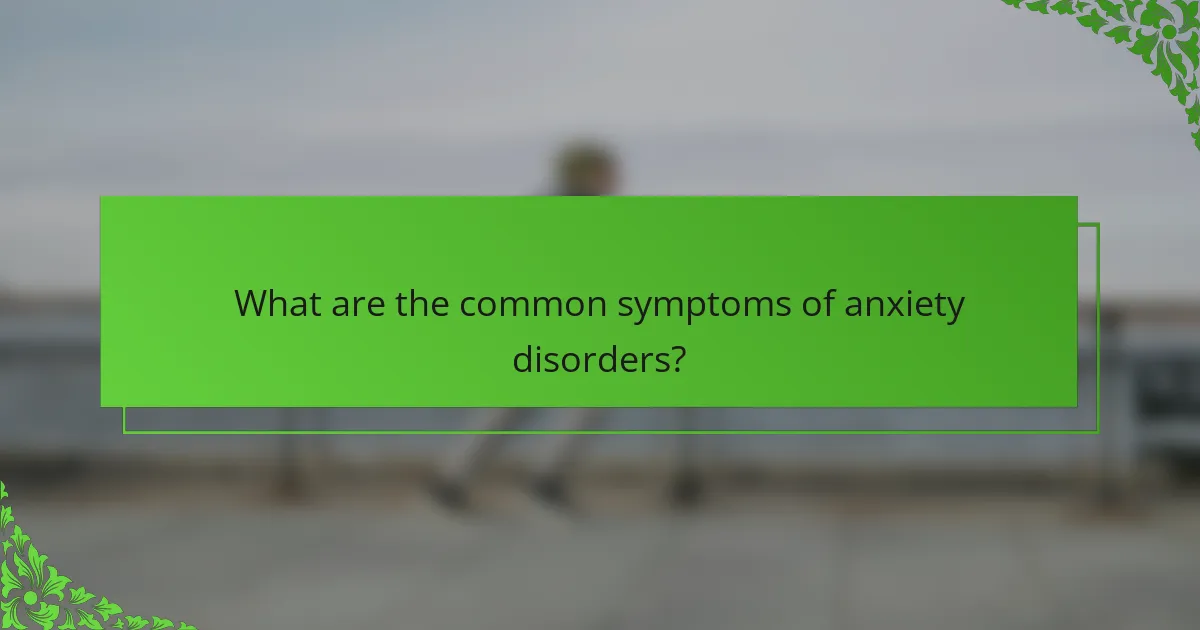
What are the common symptoms of anxiety disorders?
Common symptoms of anxiety disorders include excessive worry, restlessness, fatigue, difficulty concentrating, irritability, and physical symptoms like increased heart rate or sweating. These symptoms can vary in intensity and duration, affecting daily functioning. Anxiety disorders often manifest in different forms, such as generalized anxiety disorder, panic disorder, and social anxiety disorder, each with unique attributes. Treatment options range from therapy to medication, tailored to individual needs.
How can physical symptoms of anxiety be recognized?
Physical symptoms of anxiety can be recognized through various physical manifestations. Common signs include increased heart rate, sweating, trembling, fatigue, and muscle tension. These symptoms often occur alongside psychological signs like excessive worry or fear. Recognizing these physical cues is essential for identifying anxiety disorders and seeking appropriate treatment options.
What emotional symptoms are prevalent among those with anxiety disorders?
Emotional symptoms prevalent among those with anxiety disorders include excessive worry, fear, irritability, and restlessness. These symptoms can significantly impact daily functioning and well-being. Individuals may also experience feelings of impending doom or a sense of detachment from reality. These emotional characteristics are key in diagnosing anxiety disorders and determining treatment options.
Which cognitive symptoms are commonly reported?
Common cognitive symptoms of anxiety disorders include difficulty concentrating, excessive worry, racing thoughts, and indecisiveness. These symptoms can significantly impact daily functioning and quality of life. Individuals may also experience memory problems and a sense of impending doom. Identifying these cognitive symptoms is crucial for effective treatment and management of anxiety disorders.
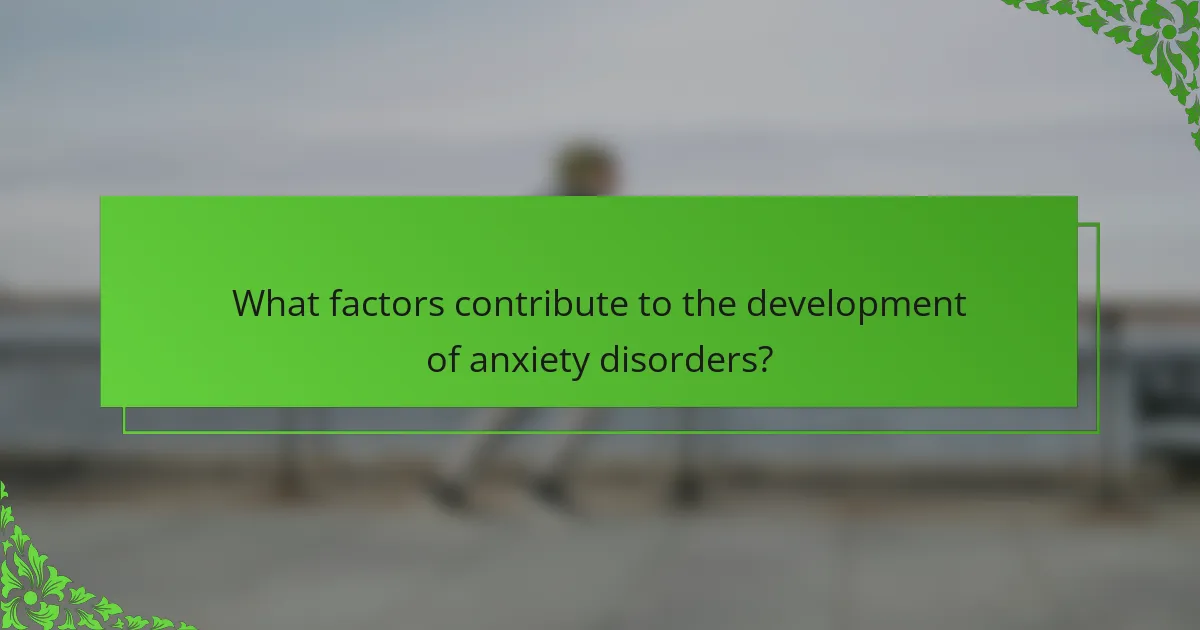
What factors contribute to the development of anxiety disorders?
Various factors contribute to the development of anxiety disorders, including genetics, brain chemistry, and environmental stressors. Genetic predisposition plays a significant role, as family history can increase risk. Neurotransmitter imbalances, particularly in serotonin and dopamine, influence mood regulation. Environmental factors, such as trauma or chronic stress, can trigger or exacerbate symptoms. Additionally, personality traits like high sensitivity or perfectionism may predispose individuals to anxiety disorders. Understanding these factors is crucial for effective treatment and management.
How do genetic predispositions influence anxiety disorders?
Genetic predispositions significantly influence the development of anxiety disorders. Research indicates that hereditary factors contribute to the risk of these conditions, with estimates suggesting that genetics account for approximately 30-40% of the risk.
Specific genes related to neurotransmitter systems, such as serotonin and dopamine, have been associated with anxiety disorders. For instance, variations in the serotonin transporter gene can affect emotional regulation and increase susceptibility to anxiety. Environmental factors, such as stress and trauma, also interact with genetic predispositions, further shaping individual experiences with anxiety disorders.
Understanding these influences can enhance treatment approaches, as genetic insights may lead to personalized therapies that consider a patient’s unique genetic makeup. This integration of genetics into mental health care represents a promising direction for improving outcomes in individuals with anxiety disorders.
What role does environmental stress play in anxiety development?
Environmental stress significantly contributes to the development of anxiety disorders. Factors such as chronic stress, exposure to violence, and environmental pollutants can trigger or exacerbate anxiety symptoms. Research indicates that individuals in high-stress environments are more likely to experience anxiety-related issues. For example, studies show that urban living, with its associated noise and pollution, correlates with increased anxiety levels. Additionally, unique stressors, like natural disasters, can lead to acute anxiety responses. Understanding these environmental impacts is crucial for effective treatment strategies.
How can lifestyle choices impact anxiety levels?
Lifestyle choices significantly influence anxiety levels by affecting mental and physical health. Regular exercise reduces anxiety symptoms by releasing endorphins. A balanced diet rich in omega-3 fatty acids and antioxidants supports brain health, while adequate sleep is crucial for emotional regulation. Stress management techniques, such as mindfulness and yoga, can lower anxiety by promoting relaxation. Conversely, excessive caffeine and alcohol intake can exacerbate anxiety symptoms. Making positive lifestyle changes can lead to improved mental well-being and reduced anxiety disorders.
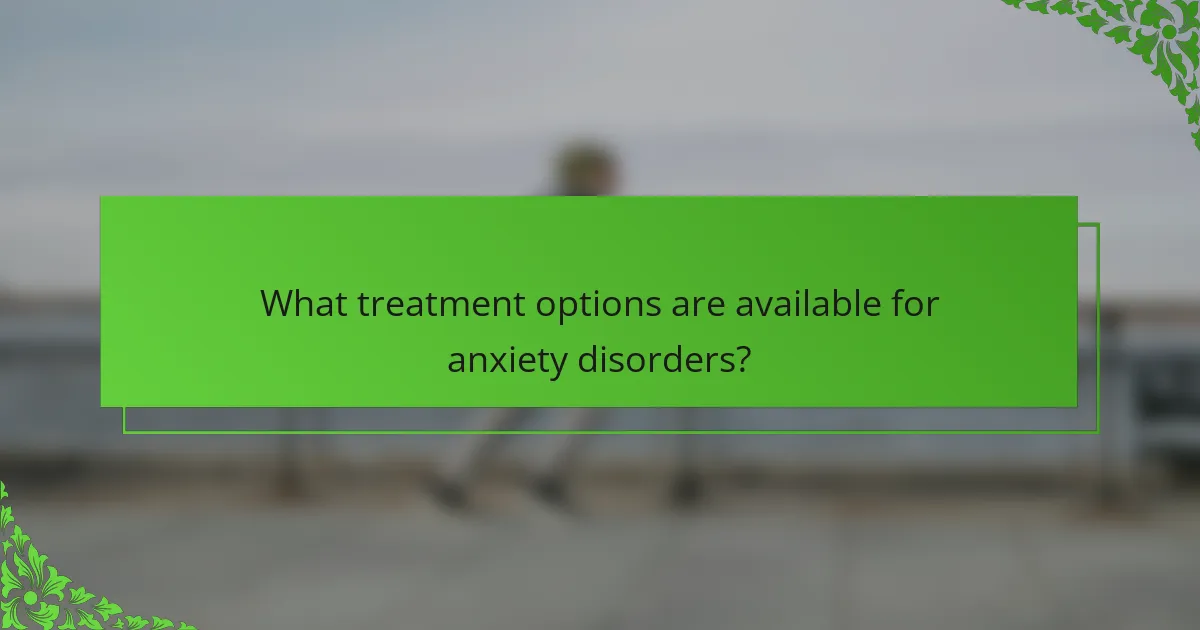
What treatment options are available for anxiety disorders?
Treatment options for anxiety disorders include therapy, medication, lifestyle changes, and support groups. Cognitive Behavioral Therapy (CBT) is a common therapeutic approach that helps individuals identify and change negative thought patterns. Medications such as SSRIs and benzodiazepines can effectively reduce symptoms. Lifestyle changes, including regular exercise and mindfulness practices, contribute to overall well-being. Support groups provide a sense of community and shared experiences, which can be beneficial for recovery.
How effective are psychotherapy and counseling for anxiety disorders?
Psychotherapy and counseling are effective treatments for anxiety disorders, providing significant relief for many individuals. Research indicates that cognitive-behavioral therapy (CBT) is particularly beneficial, often leading to a reduction in anxiety symptoms by 50-75% within several weeks of treatment.
Therapeutic approaches, such as exposure therapy, help individuals confront their fears in a controlled environment, fostering coping strategies. Additionally, the supportive nature of counseling can enhance emotional resilience and improve overall well-being.
The effectiveness of these therapies may vary based on unique attributes, including the severity of the disorder and individual response to treatment. However, studies consistently show that combining psychotherapy with medication can lead to even greater improvements in managing anxiety disorders.
What medications are commonly prescribed for anxiety management?
Common medications for anxiety management include selective serotonin reuptake inhibitors (SSRIs), benzodiazepines, and buspirone. SSRIs, such as sertraline and escitalopram, are often first-line treatments due to their efficacy and safety profile. Benzodiazepines, like diazepam and lorazepam, provide rapid relief but carry a risk of dependency. Buspirone offers a non-benzodiazepine option, effective for chronic anxiety with a lower risk of sedation. Each medication type has unique attributes affecting treatment duration and side effects, making personalized care essential.
How can lifestyle changes support anxiety treatment?
Lifestyle changes can significantly enhance anxiety treatment by promoting overall well-being. Regular exercise, for instance, reduces stress and improves mood through the release of endorphins. A balanced diet rich in omega-3 fatty acids and antioxidants supports brain health, which can alleviate anxiety symptoms. Mindfulness practices, such as meditation and yoga, foster relaxation and help individuals manage stress more effectively.
Establishing a consistent sleep schedule is crucial, as quality sleep directly impacts mental health. Social support from friends and family can also provide emotional relief and reduce feelings of isolation. These lifestyle modifications not only complement traditional treatments but can also lead to long-term improvements in anxiety management.
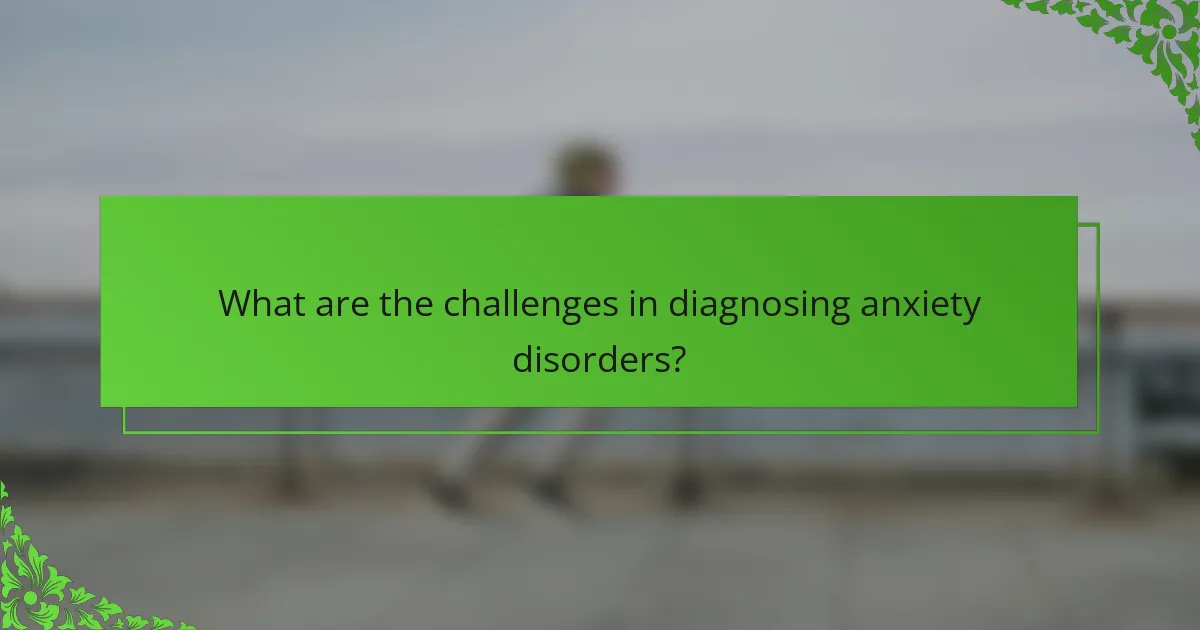
What are the challenges in diagnosing anxiety disorders?
Diagnosing anxiety disorders presents several challenges. Symptoms often overlap with other mental health conditions, complicating accurate identification. Additionally, individuals may not express their feelings clearly, leading to misinterpretation. Cultural factors can also influence symptom expression and recognition. Furthermore, the absence of definitive tests for anxiety disorders necessitates reliance on subjective assessments, which can vary widely among clinicians.
How can overlapping symptoms complicate diagnosis?
Overlapping symptoms can significantly complicate the diagnosis of anxiety disorders. Conditions like depression, PTSD, and OCD share symptoms such as restlessness, irritability, and difficulty concentrating. This symptom overlap can lead to misdiagnosis or delayed treatment. Accurate diagnosis requires careful evaluation of specific symptoms, duration, and their impact on daily functioning. Mental health professionals often use standardized assessment tools to distinguish between disorders and ensure appropriate treatment.
What are the implications of misdiagnosis in anxiety disorders?
Misdiagnosis in anxiety disorders can lead to ineffective treatment, worsening symptoms, and increased distress. Accurate diagnosis is essential for proper management and support. Mislabeling anxiety as depression or another disorder can result in inappropriate medications, delaying recovery. Additionally, it may cause patients to lose trust in healthcare providers, leading to avoidance of future treatment. Ultimately, misdiagnosis can hinder the overall quality of life and mental health for individuals affected by anxiety disorders.
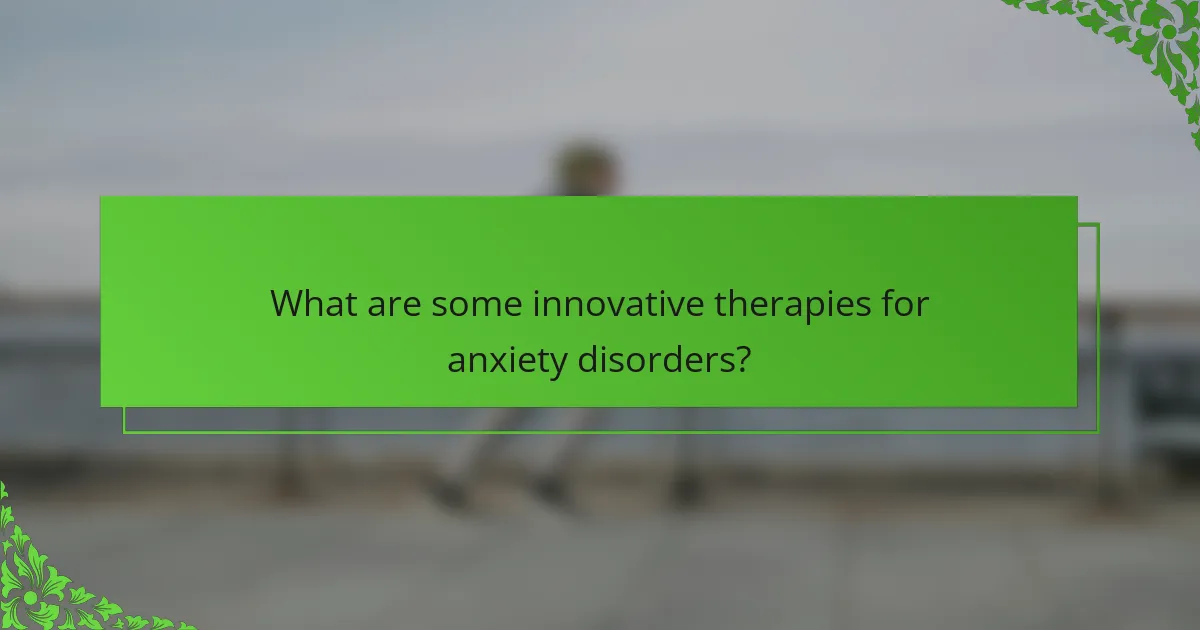
What are some innovative therapies for anxiety disorders?
Innovative therapies for anxiety disorders include cognitive-behavioral therapy, mindfulness-based stress reduction, and exposure therapy. These approaches focus on altering thought patterns, enhancing self-awareness, and gradually confronting fears.
Cognitive-behavioral therapy (CBT) effectively addresses anxiety by changing negative thought processes. Mindfulness-based stress reduction helps individuals focus on the present moment, reducing anxiety symptoms. Exposure therapy gradually exposes patients to anxiety-provoking situations, helping them manage their responses.
Emerging treatments like virtual reality exposure therapy and biofeedback are gaining traction. Virtual reality allows for controlled exposure to anxiety triggers in a safe environment. Biofeedback teaches individuals to control physiological responses, promoting relaxation and reducing anxiety.
These innovative therapies offer diverse options for those seeking effective treatment for anxiety disorders. They emphasize personalized approaches, addressing unique symptoms and experiences.
How does cognitive-behavioral therapy differ from traditional approaches?
Cognitive-behavioral therapy (CBT) focuses on changing negative thought patterns, while traditional approaches often emphasize exploring past experiences. CBT is structured and goal-oriented, making it effective for anxiety disorders. Traditional therapies may take longer to show results and often delve into emotional processing. CBT typically involves practical techniques like exposure therapy, whereas traditional methods may rely more on talk therapy. This distinction highlights CBT’s unique attribute of being time-efficient and directly applicable to anxiety management.
What role do mindfulness and meditation play in anxiety treatment?
Mindfulness and meditation significantly reduce anxiety symptoms by promoting relaxation and enhancing emotional regulation. These practices help individuals focus on the present moment, which decreases rumination and stress. Research shows that mindfulness-based interventions can lead to a 30% reduction in anxiety levels for many participants. Regular meditation fosters resilience, providing tools to manage anxiety triggers effectively. As a result, mindfulness and meditation serve as valuable components in comprehensive anxiety treatment strategies.
How is technology being used in managing anxiety disorders?
Technology is enhancing the management of anxiety disorders through various innovative tools. Mobile applications offer guided meditation, cognitive behavioral therapy exercises, and mood tracking. Virtual reality (VR) is being used for exposure therapy, allowing individuals to confront their fears in controlled environments. Teletherapy provides access to mental health professionals remotely, increasing convenience and reducing stigma. Wearable devices monitor physiological responses, helping users identify anxiety triggers in real-time. These advancements support personalized treatment plans and improve overall mental health outcomes.

What are the best practices for managing anxiety in daily life?
To manage anxiety in daily life, practice mindfulness, maintain a balanced diet, exercise regularly, establish a routine, and seek professional support. These strategies help reduce symptoms and improve overall well-being. Mindfulness techniques, like meditation, can enhance emotional regulation. Regular physical activity releases endorphins, which alleviate stress. A structured daily routine fosters stability and predictability, reducing anxiety triggers. Consulting a therapist can provide tailored coping strategies.
How can individuals implement coping strategies effectively?
Individuals can implement coping strategies effectively by identifying their triggers and employing tailored techniques. Start by recognizing specific anxiety symptoms and situations that provoke discomfort. Utilize mindfulness practices, such as deep breathing or meditation, to manage stress. Establish a routine that incorporates regular physical activity, which has been shown to reduce anxiety levels. Seek social support from friends or support groups to share experiences and gain perspective. Finally, consider professional guidance from a therapist, who can offer personalized coping strategies and cognitive-behavioral techniques.
What are common mistakes to avoid when dealing with anxiety?
Avoiding common mistakes when dealing with anxiety is crucial for effective management. Key mistakes include minimizing symptoms, neglecting self-care, and avoiding professional help.
1. Minimizing symptoms: Ignoring or downplaying anxiety can worsen the condition.
2. Neglecting self-care: Failing to prioritize sleep, nutrition, and exercise can exacerbate anxiety.
3. Avoiding professional help: Not seeking therapy or counseling limits access to effective coping strategies.
4. Relying solely on medication: Overdependence on medication without therapy may hinder long-term recovery.
5. Isolating oneself: Withdrawing from social interactions can increase feelings of anxiety.
6. Avoiding triggers: Completely steering clear of anxiety-inducing situations may reinforce fear rather than help confront it.
Which resources can provide ongoing support for anxiety management?
Resources for ongoing support in anxiety management include therapy, support groups, self-help books, and online platforms. Therapy provides professional guidance, while support groups offer shared experiences. Self-help books can provide strategies and insights, and online platforms, such as apps, deliver tools for coping. Each resource serves to enhance understanding and management of anxiety disorders.



